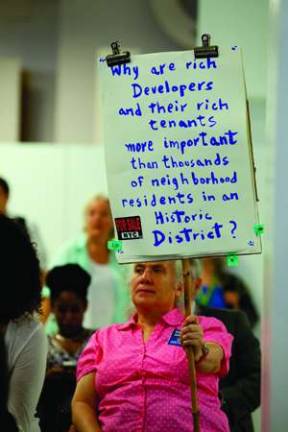Downtown Community Reacts to Hudson Square Rezoning Proposal

By Paul Bisceglio Community Board 2 (CB2) held a public hearing last week on a proposal to rezone Hudson Square, the burgeoning media district between West Houston, Greenwich and Canal Streets and Sixth Avenue. Most workers leave the neighborhood after business hours due to its lack of housing and shops, but Trinity Real Estate, owners of more than 40 percent of the area's properties, seek the city's permission to transform the neighborhood into a bustling mixed-use commercial and residential community. Local residents, business owners and activists attended the hearing to share their opinions on the company's vision, and while most agreed that Hudson Square would profit from some level of rezoning, many worried that the current plan's scale would damage the neighborhood's identity. Trinity representative Carl Weisbrod outlined the proposal, which aims, in his words, "to increase the area's special appeal to creative companies, and to protect neighborhood character." He explained that the plan would bolster retail and residential growth mostly by imposing restrictions-limiting the neighborhood's currently-uncapped building dimensions, banning most building demolitions and conversions and prohibiting large hotels and nightclubs from opening without special permits. Regulations would require wide buildings to reserve ground-floor space for retail, and Trinity would provide a 444-seat public elementary school at its own expense. The plan wants to cement Hudson Square as a "walking neighborhood," said another representative, who promised high street walls, rows of boutique shops, many trees and bike lanes. Weisbrod claimed that Trinity expects the area's residential capacity to increase up to 3,400 units (including 20 percent affordable housing) within 10 years, with construction beginning around the end of 2013. Some attendees enthusiastically supported the proposal, urging CB2 to recommend the plan to City Hall "as it is." A few speakers lined up at the microphone to applaud Trinity for considering the community's requests for building-dimension limits and a local school. "The neighborhood needs density to allow for a sustainable middle class," agreed one resident. "You need to have enough buildable area in a neighborhood so that developers will come and build." Many other attendees, however, questioned the price the neighborhood would have to pay for development. Zack Winstine, co-chair of the Greenwich Village Community Task Force, contended new retail space would only create more banks and chain stores that would homogenize the neighborhood's industrial, historic character. "I'm worried about the loss of the smaller historic buildings in the area," he told Our Town Downtown after the hearing. "Allowing residential will greatly increase the incentives for developers to knock down these buildings and build highly profitable new residential structures of the maximum size allowed by the new zoning." He noted that smaller commercial tenants also could be priced out of the area. Andrew Berman, executive director of the Greenwich Village Society for Historic Preservation, shared Winstine's concern: "The proposed building heights are just out of scale for the neighborhood. On the Duarte Square site, it would allow a building as tall as Trump SoHo, and on other major avenues it would allow buildings of 320 feet in height, which is significantly taller than virtually any other building in the neighborhood except Trump." Berman and Winstine have joined other community leaders in demanding reduced building dimensions in Hudson Square as well as landmark protection for the neighboring historic South Village, which they argue also would be at risk for over-development. Other speakers called for the preservation of more open space in the area, a commitment by Trinity to build a connection between the neighborhood and Hudson River Park on Spring Street and fewer development restrictions on properties not owned by the real estate company. The debate is just beginning to go public, with another hearing scheduled for Wednesday, Sept. 19, at the Fire Museum on Spring Street. CB2 is one of multiple committees that will consider local opinion and critique the plan over the next several months, before Trinity submits its final draft of the proposal to City Hall for approval next year.